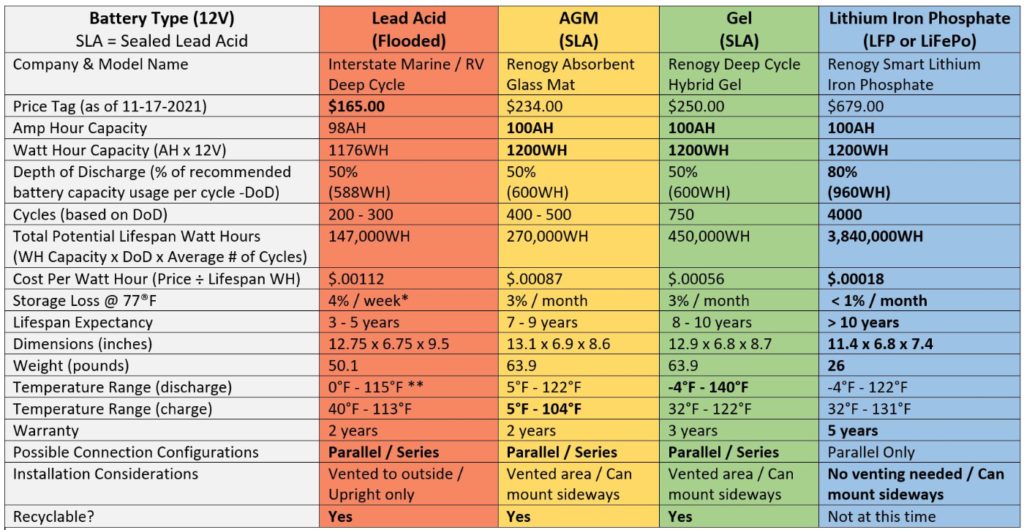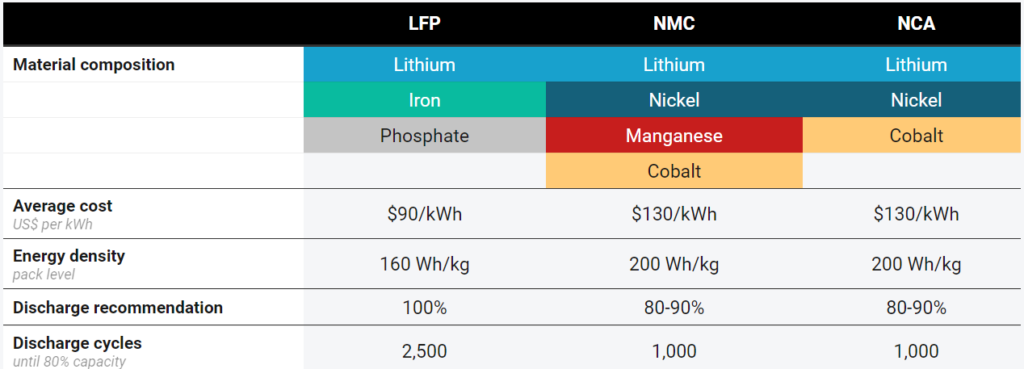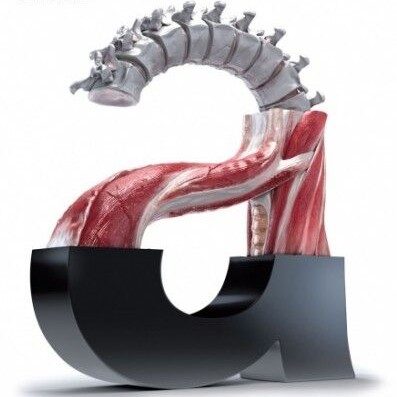
Lithium
အခုခေတ်မှာတော့ အရင် Lead Acid (Pb) ဘက်ထရီတွေ ထက် စာရင် Lithium ဘက်ထရီတွေ က နေရာ ဝင်ယူလာကြပြီ။ အစစ အရာရာ ပိုကောင်းတယ်။ အားနည်းချက် ဆိုလို့ Lead Acid Battery ထက် ဈေး ပိုကြီးတာ တခုပဲ ရှိတယ်။ Lithium ထဲမှာမှ ရွေးချယ်စရာ ထပ်ခွဲတယ် ဆိုတာ အရင်က သိပ် သတိမထားမိကြဘူး။ ဒါပေမယ့် Electric Vehicle (EV) လျှပ်စစ်မော်တော်ကား နှင့် Solar System နေအလင်းရောင်မှ လျှပ်စစ်ထုတ်ယူတဲ့ စနစ်တွေ အသုံးပြုလာတော့ ပိုသတိထားမိလာကြတယ်။
Lithium တွေလည်း ထုတ်လုပ်သူတွေ အပြိုင်အဆိုင် များလာ၊ နည်းပညာတွေ တိုးတက်လာမှုတွေ ကြောင့် အခုနောက်ပိုင်း ဈေးတွေ kW/Hr က ထက်ဝက်နီးပါးလောက် သက်သာသွားတာကို နှိုင်းယှဉ်ကြည့်ရင် သိနိုင်ပါတယ်။

တချို့သော အရောင်းဆိုင်တွေဟာ ဆိုလာစနစ် ရောင်းရာမှာ AGM or GEL ဘက်ထရီ ထည့်ပြီး မသိတဲ့သူတွေကို မရှင်းပြ။ ဆိုလာစနစ် စတပ်ချင်သူတွေကတော့ LFP ဘက်ထရီ ပါတဲ့ ဆိုလာစနစ်တွေနဲ့ ဈေးနှိုင်းယှဉ်ပြီး ဈေးသက်သာတော့ တပ်ကြ ဆင်ကြပေါ့။ ၁နှစ်လောက် ကြာတော့ ဘက်ထရီတွေ အလုပ်မဖြစ်တော့။ အဲ့လို ဂျင်း ဆိုင်တွေ ရှောင်နိုင်ရင် အကောင်းဆုံး ပဲ။ ဆိုလာ သုံးမယ် ဆို LFP ပဲ သုံးပါ။ Brand, New or Used Cell, Inverter with BMS System စသဖြင့် … ကြည့်စရာတွေ အများသား။
Depth of Discharge (DoD)
Lithium ရဲ့ Depth of Discharge (DoD) က 80% နှင့် အထက် ပါ။ DoD 80% ဆိုလိုတာက 80% အထိ ပဲ သုံးဖို့ပါ။ အဲ့ထက် ကျော်သွားရင် ဘက်ထရီ စောစောပျက်ပါတယ်။ ဒါကြောင့်မို့လို့ ဖုန်းဘက်ထရီ 100% မှာ 80% အထိပဲသုံးရမှာပါ။ 20% အောက် ဆင်း မသုံးတာ အကောင်းဆုံးပါ။
Lead Acid’s DoD က 50% ပဲ ရှိပါတယ်။ ဒါကြောင့်မို့လို့လည်း သူတို့က စောစောပျက်ကြ
Types of Lithium Batteries
Lithium Batteries တွေကို Lithium Ion Polymer / Li-Po / Li-ion စသဖြင့် အမျိုးမျိုး ခေါ်ကြပါတယ်။ သူ့မှာတော့ အောက်ဖော်ပြပါ (၅) မျိုး ထပ်ခွဲနိုင်ပါတယ်။
| Short Name | Chemical Name | Full Name | Cycles | Years | DoD | Volt |
|---|---|---|---|---|---|---|
| LFP | LiFePO4 | Lithium Iron/Ferrous Phosphate | 5,000 | 7-10 | 100% | 3.2V |
| Li-NMC | LiNiMnCoO2 | Lithium Nickel Manganese Cobalt Oxide | 2,000-2,500 | 3-4 | 80%-90% | 3.6V |
| Li-NCA | LiNiCoAlO2 | Lithium Nickel Cobalt Aluminum Oxide | 1000 | 1-2 | 3.6V | |
| LCO | LiCoO2 | Lithium Cobalt Oxide | 500-1000 | 1-2 | 3.6V | |
| LMO | LiMn2O4 | Lithium Manganese Oxide | 300-700 | 1-2 | 3.7V | |
| LTO | Li4Ti5O12 | Lithium Titanate | 15,000-20,000 | >20 | 2.4V |

LiFePO4 / LFP / Li-Po
လိုက်ပိုဖိုး / LFP / လိုင်ပို တွေက စက်မှုလုပ်ငန်းသုံး အကြီးစားလုပ်ငန်းတွေမှာ အသုံးများပါတယ်။ ဘေးအန္တရာယ် အတွက် စိတ်အချဆုံး ဆိုလည်း မှန်ပါတယ် … မမှားပါဘူး။ Cobalt လို Toxic ပစ္စည်း မပါသဖြင့် Environment friendly ပတ်ဝန်းကျင်နဲ့လည်း သဟဇာတ ဖြစ်ပါတယ်။ DoD 100% ဖြစ်တော့ အား အကုန် သုံးမိလည်း ကိစ္စ မရှိပါဘူး။ သက်တမ်းကလည်း 4,000 Cycles လောက်ထိ ရပါတယ်။ Battery Management System (BMS) နဲ့ တွဲသုံးရင်တော့ 5,000 Cycles ကျော် အထိ သက်တမ်း ပိုရှည်ကြာ သုံးနိုင်ပါတယ်။
Li-NMC
Li-NMC တွေကိုတော့ Long Range EV ကားတွေမှာ ခရီးမိုင်များများ သွားနိုင်အောင် အသုံးပြုကြတယ်။ LFP နဲ့ အလေးချိန်တူချင်း မှာ စွမ်းအင် ပိုသိုလှောင်နိုင်တာ က သူ့ အားသာချက် ပါ။ ဒါပေမယ့် ပိုဈေးကြီးတော့ ကားကုမ္ပဏီတွေက LFP ကို Budget EV & Entry Level EV တွေမှာ သုံးပြီး Li-NMC ကိုတော့ Premium Long-Range EV တွေမှာ အသုံးပြုကြပါတယ်။
Li-NMC တွင် သူ့ဆီမှာ ပါဝင်တဲ့ Nickel, Manganese, Cobalt အချိုးအစား ပေါ် မူတည်ပြီး ၃ မျိုး ထပ်ကွဲပါတယ်။
NMC 111 (Nickel 33.3% – Manganese 33.3% – Cobalt 33.3%)
NMC 622 (Nickel 60% – Manganese 20% – Cobalt 20%)
NMC 811 (Nickel 80% – Manganese 10% – Cobalt 10%)
Li-NCA
Li-NMC က Manganese အစား Aluminium အလူမီနီယမ် အစားထိုး ပါဝင်တယ်။ ဒါပေမယ့်လည်း NMC 811 လိုပဲ Nickel က 80% နီးပါးလောက် ပါဝင်ပြီး Cobalt & Aluminium တွေ က အချိုး နည်းပါတယ်။ Safety ပိုင်းမှာတော့ Li-NMC ထက် ပို အားနည်းပါတယ်။ kWH ကတော့ ပိုများတော့ EV ကားတွေမှာ တပ်ဆင် အသုံးပြု ကြပါတယ်။
LCO
LCO တွေကို ဖုန်း၊ ကင်မရာ၊ လက်တော့ ဘက်ထရီတွေမှာ အဓိက အသုံးပြုကြတယ်။ ပြန်အားသွင်းတာ မြန်တယ်။ ဒါပေမယ့် High Load ပါဝါစားတာများလာရင် ဘက်ထရီ ပူလာတာမျိုးတွေ ရှိတယ်။
LMO
LMO တွေကိုလည်း အသေးစား စက်ပစ္စည်းတွေ ဖြစ်တဲ့ လျှပ်စစ်စက်ဘီး၊ ဆေးစက်ပစ္စည်း၊ Drill ဖောက်စက်၊ Screwdriver ဝက်အူလှည့်စက် တွေမှာ အသုံးပြုတယ်။ သူကတော့ LCO နဲ့ ဆင်တူပြီး Cobalt အစား Manganese သုံးထားတော့ အပူ ပြဿနာ သိပ်မရှိဘူး။
LTO
LTO / Lithium Titanate ကျတော့ အသုံးနည်းတော့ ကြားဖူးတာ သိပ်မတွေ့ရသလောက်ပဲ။ Titanium တိုက်တေနီယမ် ဆိုတဲ့အတိုင်းပဲ ဈေးကြီးပါတယ်။ အစွမ်းထက်ပါတယ်။ အပူချိန် ခံနိုင်ရည် (အေးလွန်း ပူလွန်း) အား ကောင်းပါတယ်။ ဒါကြောင့် Heavy Duty Machine ကရိန်းကားတွေ မြေသယ်ယဉ်တွေ မှာ အသုံးပြုကြတယ်။ Life Cycle ကလည်း LFP ထက်တောင် ၃-၄ ဆလောက် များတော့ နှစ် ၂၀ နှင့် အထက် အေးအေးဆေးဆေး စိတ်ချလက်ချ အသုံးပြုနိုင်ပါတယ်။
Summary

- Specific Energy or Gravimetric Density [Wh/Kg]: is the ratio of the amount of energy contained (Wh = V x Ah) to the weight of the battery.
ဘက်ထရီ အလေးချိန် တခု ကနေ ထုတ်ပေးနိုင်တဲ့ စွမ်းအင် ပမာဏ - Safety: which is closely related to thermal stability because intrinsic safety depends very much on how thermally stable the components are
လုံခြုံစိတ်ချရမှု – အပူချိန် ခံနိုင်ရည် (အေးလွန်း ပူလွန်း) အေးလွန်းရင် အလုပ်မလုပ်ဘဲ ရပ်၊ ပူလွန်းရင် မီးလောင် စသဖြင့် .. - C- Rate: charge/discharge rate, i.e. the ratio between the charge or discharge current (A) and the nominal capacity of the cell (Ah). This is a parameter closely linked to the cell’s ability to generate power.
လျှပ်စစ် ထုတ်လွှတ်အား - Life cycle: Number of times the cell can be discharged and charged until the end of life is reached, normally considered when 80% residual capacity is reached.
ဘက်ထရီ သက်တမ်း – အားကုန် အားသွင်း လုပ်လို့ ရတဲ့ အကြိမ် အရေအတွက် - Cost
ကုန်ကျစရိတ် / ဈေးနှုန်း
New or Used Cell ?
New Cell အသစ် လား Used Cell အဟောင်း လား
Brand အမှတ်တံဆိပ် ကြည့်ရမယ့် အပြင် … ဖြစ်နိုင်ရင် ကိုယ်တိုင် စမ်းသပ်လို့ ရတာ အကောင်းဆုံး ပဲ။
ဂျင်း ထည့် မခံရဖို့တော့ အရေးကြီးတာပေါ့ဗျာ !!!
စည်သူအောင် (STA)
.\rrr\uu comment
ကျနော် ကတော့ EV ပဲ ဝယ်ဝယ်၊ အိမ်မှာ Solar ပဲ တပ်တပ် … LFP ပဲ အားပေးတယ် … ဘာလို့လဲ အခြား Lithium တွေနဲ့ ယှဉ်ရင် Safety စိတ်ချရတယ်၊ Life Cycle ပိုများတော့ ပိုကြာကြာသုံးရတယ်၊ Price ဈေးသက်သာတယ်။
Reference
Flash Battery | Let’s discover the different types of batteries
